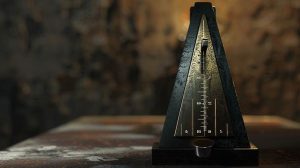
The Benefits of the Ear to Instrument Connection
I recently watched a video performance by the amazing classical pianist Yuja Chang. I’ve seen her memorizing motion and heard her virtuosic playing before, but something hit me after seeing
Categories:
Categories:
Thank you for all the positive comments and emails from last week’s post on building your health.
As I thought about all those people wanting to make change, I was reminded of another topic that is super important to the idea of making material change: the willingness to try something new and different from what you’ve always done.
It’s been said that doing the same thing over and over again expecting different results is ‘insanity’. I don’t think it’s insanity, I think it should be called ‘futility’.
Repeating the same habits over and over expecting something to change relates far beyond what you do for your health. This also relates to your ability to play your instrument and jazz better–more like you imagine.
Think about your practice routine. How much of it is the same each and every time? Are you using a rubber stamp to make it through your playing time and effort?
Consider what you practice. The same scales in the same direction, the same etudes, the same tunes in the same keys, music out of the same books?
Consider where you practice. The same room with the same acoustics and the same vibe?
And consider how you practice. Do you always start at the beginning and play straight through to the end of etudes, exercises, or tunes? Except for drummers and piano players, do you always sit in the same chair pointed in the same direction thinking the same things? Do you record yourself? Is listening to your own playing live as you play the only perspective you have of how you or your band sounds?
If you’re doing the same things over and over and wondering why your playing is not getting better and more fun, could there be an element of futility in how you’re spending your playing time?
I’m not suggesting that repetition is bad. Learning to play a musical instrument requires the effort of relentless repetition. Scales and exercises over and over until you’re dreaming about them, playing the tunes you wish to learn over and over until you’re sick of them, working your fingers and arms until they hurt or those muscles just give out (give up).
Think about the long-term effects of settling into a routine for the sake of routine. Paying more attention to the clock on the wall than on the details of your sound, prioritizing quantity over quality, the proverbial gold star you gave yourself because you practiced today, no longer expecting significant improvement in your playing. Do you keep your practicing and performing fresh or are you stuck in a rut? The months are turning into years…

Are you doing the same things over and over expecting different results?
If you sense that you might be, then think of something different to do practicing or performing, but then do it. Mix it up. Mixing things up and expanding the diversity of how you approach music gives you a better broader perspective on your playing. What’s more important than hearing yourself better, closer to how others hear you, both in your playing’s nuance and musical personality.
I think of musical hearing in two related ways: First, with the microscope, you hear the detail of your playing: intonation, time, dynamics, inflection, and tone.
Second, and with a telescope, you hear the personality of your musical voice. The big picture: your energy, your attitude, your kinship with the other musicians, the musical relationship you have with your audience.
Why does all that matter? Because you can’t improve that which you don’t hear. And there is more than just one level to hear within your playing. Improving requires that you hear what needs to be worked on or what else is going on beneath the surface. You probably have a sound in your head that you imagine playing like some day.
To get there, you need to more clearly hear how you play today and the difference between you and your model. Then hopefully later, you’ll hear your own musical voice so clearly that you abandon the sound of your idol/model, and project yourself. I know you have something worthwhile to say.
So if I’ve sold you on the benefits of hearing more, let me recommend 7 aspects of practicing and performing that I hope will motivate you to try some new things.
Again, I’m not telling you to stop your repetition of scales, tune learning, and muscle development. Work hard on those things but do so within your new and fresh perspectives.
Here are 7 tips off the top of my head that can freshen your perspective on how you play, and open up your ears to knowing better how you can improve.

As you read think about changing up your routine, what is your knee-jerk emotional reaction to that idea? Was your initial reflex to think of reasons why a particular change can’t work for you? That’s perfectly normal, since routine is hard-wired into each of us as a survival mechanism. Your brain is built to be energy-efficient, not to crave new and more strenuous ways to accomplish repetitive tasks.
But accomplishing something as challenging as playing jazz well requires that you go above and beyond your default hard wiring that is built for efficiency through unthinking habit and routine.
Do just one of the suggestions above and honestly consider your experience and 30-day results.
Ask any accomplished musician what they did to master their art. I’m betting they won’t tell you they followed a routine of habitual comfort.
And if you need one more example of the life-changing effects from thinking different(ly), here’s one from another of life’s great geniuses:

Trombonist, author, marketer, & tech guy
Share this post…

I recently watched a video performance by the amazing classical pianist Yuja Chang. I’ve seen her memorizing motion and heard her virtuosic playing before, but something hit me after seeing

I have created a AI chatbot called Jazz Master Chat that draws from 75 hours of interviews from my Jazz Master Summit event a couple of years ago. I interviewed

What is jazz improvisation? Let’s first define what I mean by jazz improvisation. Jazz improvisation is a spontaneous conversation, but instead of words, we use notes. Look at two possible

My recently turned 18-year old son is a passionate photographer. He’s got himself a little business where people pay

A couple weeks ago I sent Richie Beirach a YouTube clip from the movie Whiplash as a bit of

I originally meant to write this as a reply to a comment Richie Beirach wrote on my blog. But

Tools for helping musicians at all levels learn about jazz and play to their full capability.
Web design and marketing by:
Michael Lake @JazzDigitalMarketing.com
This is just a fake book example for the type of website I can build for you. Just trying to use a little humor here!
6 thoughts on “Uplift your playing: try something new”
All the important wisdom contained in human knowledge can be found in Seinfeld!
I concur!
I knew we were meant to be jazz pals – not only because of your fab posts and published books (I’ve bought 2 so far – love them!) – the George reference was the icing on the cake.
PS: This post hits me in all the right spots. DSD – do something different. I hear you and I’m digging in firstly by changing where & how I am when practicing. 👏👏
It’s not “pocket Jazz” it’s “Pocket therapy” for the struggling, intimidated, embarrassed, wanna-be musician. I gain so much from your suggestions and insights. They make absolute perfect sense and I will adopt and adapt. I need them, my brain needs them, and my music will thank me. Thank you for being that “tough love” friend.
I truly appreciate you!
Neil
Once again, an essay full of practical and stimulating ideas. Thank you. Earlier this year I bought a pear wood descant recorder. I have been recording the piano chords and playing the melody on the recorder. It’s fun and presents a novel challenge. I also like to play through the pentatonic scales while looking out to the garden. They go together perfectly. Spotify has an album called History Has A Heartbeat by Joseph Tawadros and William Barton – a master oud player and Australia’s leading yidaki (didgeroo doo) player. It is an unusual combination but very innovative, beautiful and original.
Hi, Michael –
Because I don’t own a computer, and do everything from my phone, I usually refrain from commenting due to time constraints.
However, it’s wrong of me not to thank you for all of these wonderful essays, as there always is something in them that is helpful and uplifting (the one on sleep made me smile, in particular, as I’d just returned from playing at week-long corporate convention, and one of the seminars for which I’d played a bit dealt with this very subject!)
With humility, may I add a suggestion to the list? (I’m at the library, with computer access, and it’s been on my mind since I first read this.)
The challenge is to take a favorite tune, or one one has wanted to learn, and do some research on it. Find the original sheet music, and if it’s from a show, find the score as well. See and learn the chord changes as the composer conceived of them. Look at the voicings, especially in the show scores, and even those on the “dumbed down” versions of the commercial sheet music – not the chord symbols above the staff, since those are ukulele chords and don’t always tell the whole story (Richard Rodgers was particularly strict about these things); look for strong counter-lines and counter-melodies that appear again and again.
Dick Hyman edited two wonderful collections of lead sheets doing this very thing, and above the original chords, suggested hipper, and oft-played alternate chords.
The benefits of this are many. If you know how the melody was originally conceived and played, you can be a lot more original when you make your departure, because then the conception is entirely your own. Finding recordings on YouTube of when the songs were new can be very instructive.
I came up in the tail -end of when those “society” bands still existed in NYC, and the musicians who mentored me knew a lot of this information, even though they also were great Jazz players, and their knowledge ran deep.
I got to thinking about this after hearing a recording, and later seeing a video, of Monk playing “Sweetheart of all my Dreams.”
When I decided I wanted to learn it, the record collector in me found old recordings, like Rudy Vallee’s, Nat Shilkret, etc. They played it in Ab, Monk played it in F. I found the original sheet music very cheaply on Ebay – also in Ab.
Finding and buying the sheet music might be taking it a bit far (I love collecting old sheet music, but that’s me) but my point is, when listening to performances of the tune by younger players on YouTube, I noticed a couple of things: they all played it in F, like Monk, and they all played – every one of them – his turnaround in the seventh and eighth bars. This made me wonder if they were doing his arrangement, or if they thought that turnaround was part of the melody.
Obviously, there isn’t time and it isn’t practical to do this kind of research every time for every tune, but as it’s rather rewarding work, it’s something to consider doing for a tune you really love, or want to learn. (For standards, it’s nice at lest to be familiar with the verse, if not learn it outright.)
Happy practicing!